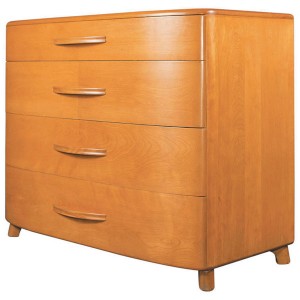Heywood Brothers built their first chair in the family barn in 1826. Over the next decade they grew into one of the most respected furniture factories in the U.S., challenged only by the opening of the Wakefield Rattan Company in 1855. After 40 years as each other’s top competitor the two joined forces in 1897 as Heywood Brothers and Wakefield Company, and it was a case of “everybody else move over.”
From 1897 through the 1920s the Massachusetts based company produced what is considered by many to be the finest quality rattan and wicker furniture in the world. Business was booming but times were changing. As savvy in business as they were in manufacturing, they knew if they wanted to remain at the top of their game that change was inevitable. They shortened their name to Heywood-Wakefield and introduced their classic Art Deco inspired line, “Modern.”
The incredible success of the “Modern” line can be attributed, at least in part, to the timing of its release. In the last half of the 1930s the American public was in a state of recovery from the devastation of the Great Depression. The fresh clean lines and simple elegance of “Modern” was a stark contrast to the dark, ornate furniture of the ‘20s and early ‘30s. Quite simply, it was fun!
The basic idea was to manufacturer furniture made from Northern yellow birch with rounded bentwood corners and without even a hint of ornamentation. Working from this foundation, HW sought the talents of some of the top industrial designers of the day including Russel Wright, Joseph Carr and Gilbert Rohde. The end result was a line of blonde furniture that would fill the dining rooms, living rooms and bedrooms of America from the end of the 1930s through the end of the 1950s.
Through the years a number of different marks were used by the company. Knowing them will help you to determine if the piece is original issue or new. The earliest “Modern” wood pieces will have a yellowish wood-grain label with red print on the back or the bottom. This was replaced with a red and blue paper label around 1940. The Heywood-Wakefield eagle trademark was added in 1946. Early upholstered pieces will have a cloth tag. To better understand the marks through the years visit woodysantiques.com/aboutheywoodwakefield.
As we entered the ‘60s the public’s fascination with Heywood-Wakefield furniture waned. The high quality that had once kept them in demand now worked against them as shoppers looked for less expensive ways to furnish their homes. The last of the original “Modern” line was produced in 1966.
Vintage Heywood-Wakefield can be found in abundance through online auctions, but buyer beware! Before you purchase ask questions, request close up pictures of any damage and validate the authenticity on the piece you are considering. Until next time…Linda
Linda Kennett is a professional liquidator specializing in down-sizing for seniors and the liquidation of estates and may be reached for question or comment at 317-258-7835 or lkennett@indy.rr.com



